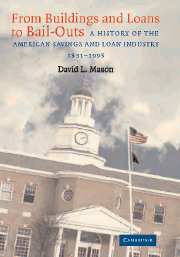 From Buildings and Loans to Bail-Outs
From Buildings and Loans to Bail-Outs Book contents
- Frontmatter
- Contents
- List of Tables
- Acknowledgments
- Introduction
- 1 A Movement Takes Shape, 1831–1899
- 2 The Rise of the League, 1900–1929
- 3 From State to Federal Oversight
- 4 The Movement Becomes an Industry, 1930–1945
- 5 The Glory Years, 1946–1955
- 6 External Challenges and Internal Divisions, 1956–1966
- 7 Lost Opportunities, 1967–1979
- 8 Deregulation and Disaster, 1979–1988
- 9 Resolving the Crisis, Restoring the Confidence, 1989–1995
- 10 The American Savings and Loan Industry in Perspective
- Appendices
- Bibliography
- Index
6 - External Challenges and Internal Divisions, 1956–1966
Published online by Cambridge University Press: 29 October 2009
- Frontmatter
- Contents
- List of Tables
- Acknowledgments
- Introduction
- 1 A Movement Takes Shape, 1831–1899
- 2 The Rise of the League, 1900–1929
- 3 From State to Federal Oversight
- 4 The Movement Becomes an Industry, 1930–1945
- 5 The Glory Years, 1946–1955
- 6 External Challenges and Internal Divisions, 1956–1966
- 7 Lost Opportunities, 1967–1979
- 8 Deregulation and Disaster, 1979–1988
- 9 Resolving the Crisis, Restoring the Confidence, 1989–1995
- 10 The American Savings and Loan Industry in Perspective
- Appendices
- Bibliography
- Index
Summary
The second decade after World War II presented far more challenges and uncertainties for the thrift industry than the earlier “glory years.” One major challenge thrifts faced was finding lending opportunities and ways to attract funds, problems tied to slower economic growth and the significant increase in competition from other financial industries and the federal government. A second critical concern was the need to give greater attention to the home ownership needs of minority groups, resulting from the growth of a national civil rights movement. Finally, thrifts had to contend with more vigorous federal oversight, a situation that reflected the work of several dynamic regulators. Despite such challenges, the thrift industry maintained a very strong growth rate in the late 1950s and early 1960s, during which time it surpassed the $100 billion (U.S. billion) asset milestone and achieved control of nearly half the residential home finance market. This expansion, however, also led to greater divisions within the thrift industry. Differences between large and small thrifts, those in the eastern half of the country and those in the faster growingWest, as well as between mutually owned and publicly traded S&Ls were all signs that the industry was becoming fragmented. For its part, the League tried to bridge these rifts, but by the mid-1960s it was apparent that these gaps had instead widened. The most significant challenge for the League and the industry, however, lay in trying to prevent the imposition of legal controls on savings rates.
- Type
- Chapter
- Information
- From Buildings and Loans to Bail-OutsA History of the American Savings and Loan Industry, 1831–1995, pp. 159 - 186Publisher: Cambridge University PressPrint publication year: 2004
